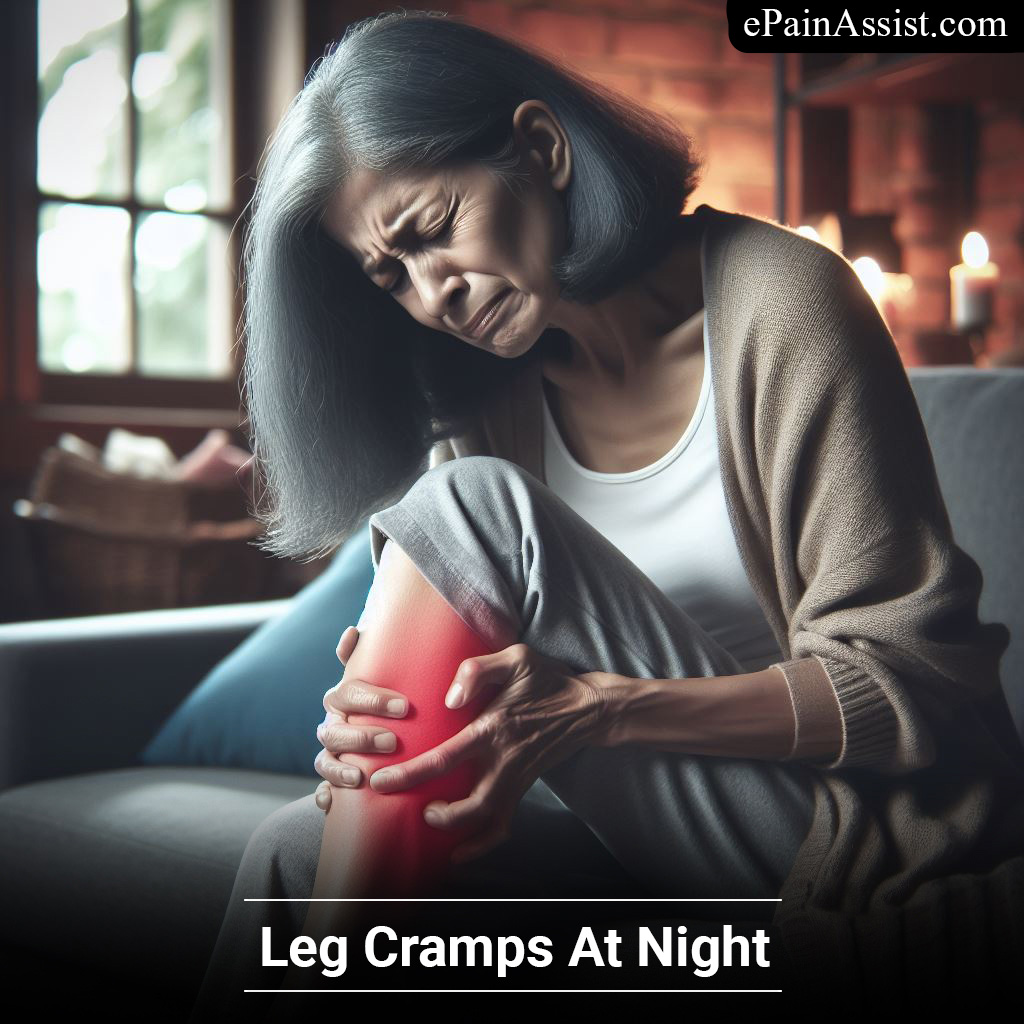Leg Cramps at Night
Leg cramps at night mostly occur when you are sleeping. The contractions come on suddenly and most commonly occur in the calf muscle, but can also occur in the thigh and feet.
Leg cramps are very painful and make the affected muscles feel tight and knotted. A person might feel soreness in the muscles for seconds or several minutes and even after the cramp goes away.

Nocturnal leg cramps are common in elderly above 50 years of age but can also affect younger adults and children. Both men and women are equally affected by the condition.
Why Do Leg Cramps Occur at Night?
Though there are not many identified causes, the night cramps can be related to muscle fatigue and nerve problems.
The risk of suffering from leg cramps at night increases with age(1). Pregnant women are at an increased risk of suffering from leg cramps at night.
Certain health conditions such as kidney failure, diabetic nerve damage, hypothyroidism, and Parkinson’s disease, can cause leg cramps at night.
People taking diuretics are more likely to have night leg cramps.
Some other factors leading to leg cramps are,
- Sitting for long hours
- Overexerting the muscles
- Standing or working on concrete floors
- Inappropriate sitting habits
Symptoms of Leg Cramps
Leg cramps occur when there is a sudden pain in the muscle of the leg caused by an involuntary contraction of the muscles present.
Research(2) done on differentiating it from other sleep-related disorders state the symptoms of nocturnal leg cramps as,
- Intense pain
- Duration from a few seconds to 10 minutes
- Location in calf and foot
- Persistent subsequent pain
- sleep disruption and distress
During an episode of cramping the affected muscle tighten and become painful. The feet and the toe may also feel stiff.
The stiffness and pain may be felt even after a few hours have passed of the occurrence of the leg cramp.
Treatment For Leg Cramps at Night
There is no medication recommended for leg cramps. In severe cases, the soreness of the muscles can be relieved by the over-the-counter painkillers.
- Mostly leg cramp can be relieved by exercising the affected muscles. Exercise reduces the frequency of the occurrence of leg cramps.
- Stretching exercises prove to be extremely helpful in such cases.
- While the cramp is occurring you can try these to ease the condition:
- Slowly straighten the leg and pull up the toes towards the knees. This stretches the calf muscles.
- Walk on tiptoes for a few minutes
Stand about one meter away from the wall, with the feet flat on the floor. Lean forward towards the wall, with the arms stretched out and the hands flat on the wall. Hold in for 10 seconds and slowly return to an upright position.
These exercise help relieve leg cramps at night and also prevent future episodes.
Heat and cold application also help relieve the cramped muscle. Use a warm towel or a heating pad on the tight muscle. You can also take a warm bath and direct the stream of a hot shower on the cramped muscle. Alternatively, apply ice of the area. It relieves pain.
How to Prevent Leg Cramps at Night?
There are a few night time advice which if followed can prevent the occurrence of leg cramps at night.
- While you lie on back, make your toe point upward. Put a pillow on its side at the end of the bed and the soles of the feet propped up against it. This helps keep the feet in the right position.
- If you sleep on your front, hand your feet over the end of the bed. This keeps the feet in a relaxed position and helps soothe muscles in calves from contracting and tensing.
- Keep the sheets and the blanket loose.
Keep yourself hydrated and keep up with the exercise schedule to keep the leg cramps away.
- MedicalNewsToday: “What to know about nocturnal leg cramps”: https://www.medicalnewstoday.com/articles/180160
- Mayo Clinic: “Leg cramps”: https://www.mayoclinic.org/diseases-conditions/leg-cramps/symptoms-causes/syc-20350820
- Cleveland Clinic: “Leg Cramps”: https://my.clevelandclinic.org/health/diseases/17069-leg-cramps
Also Read:
- What Can Cause Leg Cramps and Treatment To Stop Cramping of Leg Muscles
- Leg Cramps While Walking, Know its Causes and Treatment
- Causes of Leg Cramps While Swimming & Ways to Deal With it?
- What Are You Lacking When You Get Leg Cramps?
- Do Bananas Help With Leg Cramps?
- How To Stop Leg Cramps Fast?
- Are Leg Cramps A Sign Of Blood Clots?
